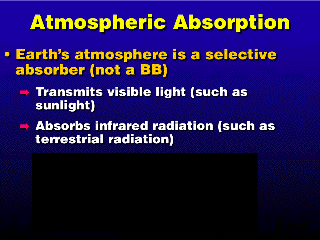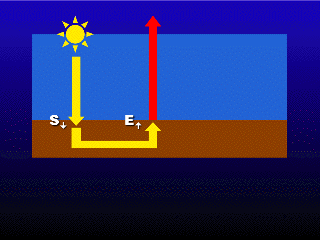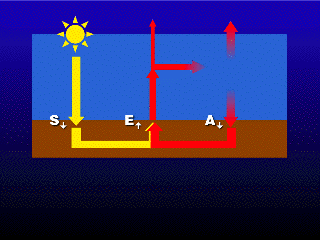 The Earth's atmosphere is not a blackbody, it is a selective absorber.
Greenhouse gases allow the sun's radiation (mostly
in the visible) to penetrate to the ground as if there was no atmosphere, but
they absorb some of the IR that is emitted from the Earth to space. [see
Quicktime movie, in a new
window] This absorption delays the transmission of radiation from the Earth's
surface out to space, so the atmosphere experiences a warming from the extra
energy kept in it.
The Earth's atmosphere is not a blackbody, it is a selective absorber.
Greenhouse gases allow the sun's radiation (mostly
in the visible) to penetrate to the ground as if there was no atmosphere, but
they absorb some of the IR that is emitted from the Earth to space. [see
Quicktime movie, in a new
window] This absorption delays the transmission of radiation from the Earth's
surface out to space, so the atmosphere experiences a warming from the extra
energy kept in it.
An important concept of blackbody
radiation is that there is a direct correlation between the amount of radiation
emitted by the blackbody and its temperature: the hotter it is, the more
radiation it emits per unit time. We can also twist this around to say that
the more radiation a blackbody emits in a given amount of time, the hotter it
is.
 In the case of the Earth having no atmosphere (or an atmosphere that is a
blackbody), sunlight (S) is absorbed at the ground, and infrared terrestrial
radiation (E) is emitted upward to balance the incoming sunlight. The IR emitted
is going out at a rate that corresponds to a blackbody temperature of 255
K. This is much colder than observed surface temperatures (around 290K),
so it appears that the atmosphere will need to have a warming effect on Earth.
In the case of the Earth having no atmosphere (or an atmosphere that is a
blackbody), sunlight (S) is absorbed at the ground, and infrared terrestrial
radiation (E) is emitted upward to balance the incoming sunlight. The IR emitted
is going out at a rate that corresponds to a blackbody temperature of 255
K. This is much colder than observed surface temperatures (around 290K),
so it appears that the atmosphere will need to have a warming effect on Earth.
 Adding in an atmosphere around Earth, we have the same amount of sunlight
reaching the ground as before (the atmosphere does not absorb the visible radiation
in sunlight) but the IR emission from the ground will be partially absorbed
by the atmosphere. The absorbed energy is then emitted by the atmosphere to
the ground and space as IR (A). The IR emitted to the ground is absorbed by
the ground, which increases the amount of energy absorbed by the ground over
the amount for the no-atmosphere case (S+A vs. just S). For radiative equilibrium,
the Earth has to radiate more upward to compensate for the increased amount
absorbed (E'=S+A vs. E=S), and the higher radiation emission rate corresponds
to a higher temperature at the surface. The Earth's surface temperature
is 288 K instead of 255 K.
Adding in an atmosphere around Earth, we have the same amount of sunlight
reaching the ground as before (the atmosphere does not absorb the visible radiation
in sunlight) but the IR emission from the ground will be partially absorbed
by the atmosphere. The absorbed energy is then emitted by the atmosphere to
the ground and space as IR (A). The IR emitted to the ground is absorbed by
the ground, which increases the amount of energy absorbed by the ground over
the amount for the no-atmosphere case (S+A vs. just S). For radiative equilibrium,
the Earth has to radiate more upward to compensate for the increased amount
absorbed (E'=S+A vs. E=S), and the higher radiation emission rate corresponds
to a higher temperature at the surface. The Earth's surface temperature
is 288 K instead of 255 K.



 The Earth's atmosphere is not a blackbody, it is a selective absorber.
Greenhouse gases allow the sun's radiation (mostly
in the visible) to penetrate to the ground as if there was no atmosphere, but
they absorb some of the IR that is emitted from the Earth to space. [see
Quicktime movie, in a new
window] This absorption delays the transmission of radiation from the Earth's
surface out to space, so the atmosphere experiences a warming from the extra
energy kept in it.
The Earth's atmosphere is not a blackbody, it is a selective absorber.
Greenhouse gases allow the sun's radiation (mostly
in the visible) to penetrate to the ground as if there was no atmosphere, but
they absorb some of the IR that is emitted from the Earth to space. [see
Quicktime movie, in a new
window] This absorption delays the transmission of radiation from the Earth's
surface out to space, so the atmosphere experiences a warming from the extra
energy kept in it. In the case of the Earth having no atmosphere (or an atmosphere that is a
blackbody), sunlight (S) is absorbed at the ground, and infrared terrestrial
radiation (E) is emitted upward to balance the incoming sunlight. The IR emitted
is going out at a rate that corresponds to a blackbody temperature of 255
K. This is much colder than observed surface temperatures (around 290K),
so it appears that the atmosphere will need to have a warming effect on Earth.
In the case of the Earth having no atmosphere (or an atmosphere that is a
blackbody), sunlight (S) is absorbed at the ground, and infrared terrestrial
radiation (E) is emitted upward to balance the incoming sunlight. The IR emitted
is going out at a rate that corresponds to a blackbody temperature of 255
K. This is much colder than observed surface temperatures (around 290K),
so it appears that the atmosphere will need to have a warming effect on Earth. Adding in an atmosphere around Earth, we have the same amount of sunlight
reaching the ground as before (the atmosphere does not absorb the visible radiation
in sunlight) but the IR emission from the ground will be partially absorbed
by the atmosphere. The absorbed energy is then emitted by the atmosphere to
the ground and space as IR (A). The IR emitted to the ground is absorbed by
the ground, which increases the amount of energy absorbed by the ground over
the amount for the no-atmosphere case (S+A vs. just S). For radiative equilibrium,
the Earth has to radiate more upward to compensate for the increased amount
absorbed (E'=S+A vs. E=S), and the higher radiation emission rate corresponds
to a higher temperature at the surface. The Earth's surface temperature
is 288 K instead of 255 K.
Adding in an atmosphere around Earth, we have the same amount of sunlight
reaching the ground as before (the atmosphere does not absorb the visible radiation
in sunlight) but the IR emission from the ground will be partially absorbed
by the atmosphere. The absorbed energy is then emitted by the atmosphere to
the ground and space as IR (A). The IR emitted to the ground is absorbed by
the ground, which increases the amount of energy absorbed by the ground over
the amount for the no-atmosphere case (S+A vs. just S). For radiative equilibrium,
the Earth has to radiate more upward to compensate for the increased amount
absorbed (E'=S+A vs. E=S), and the higher radiation emission rate corresponds
to a higher temperature at the surface. The Earth's surface temperature
is 288 K instead of 255 K.